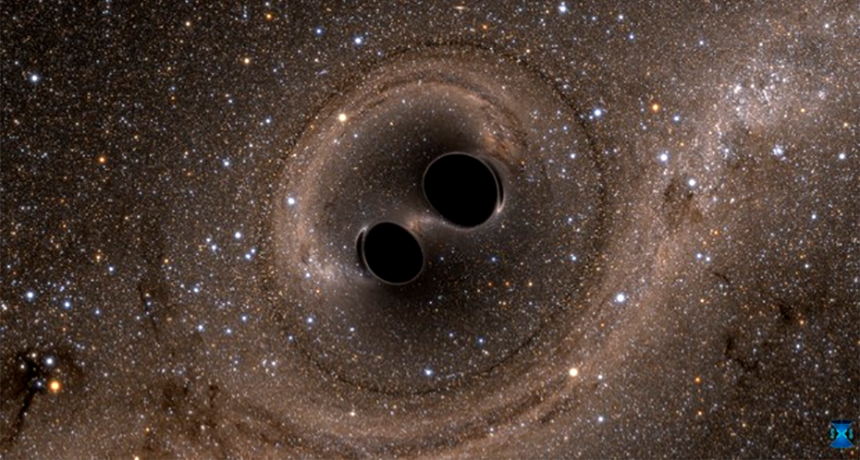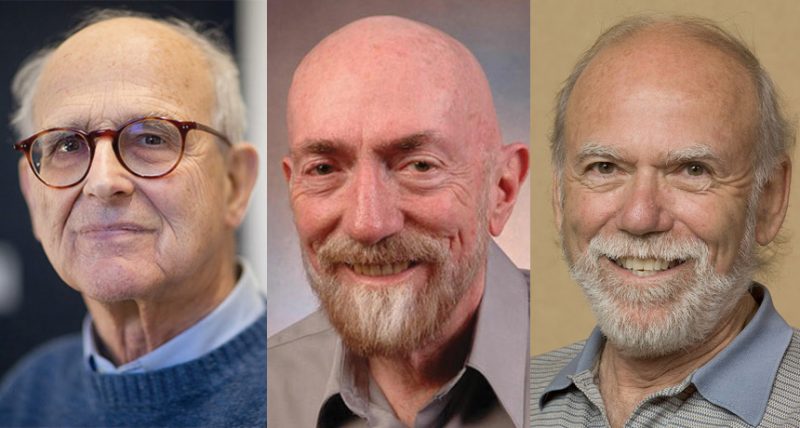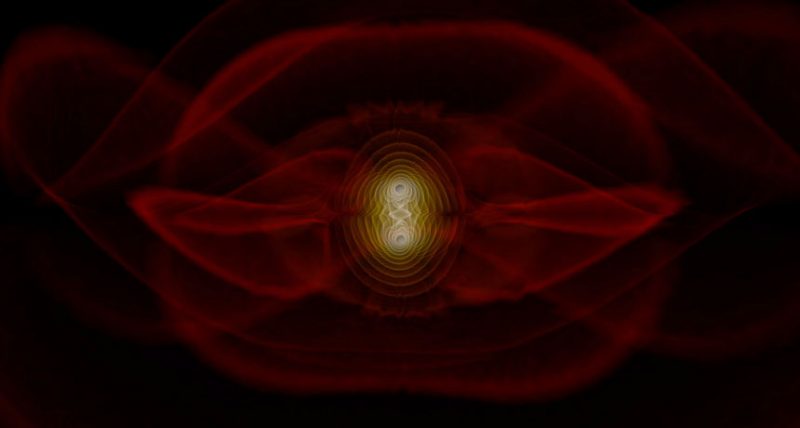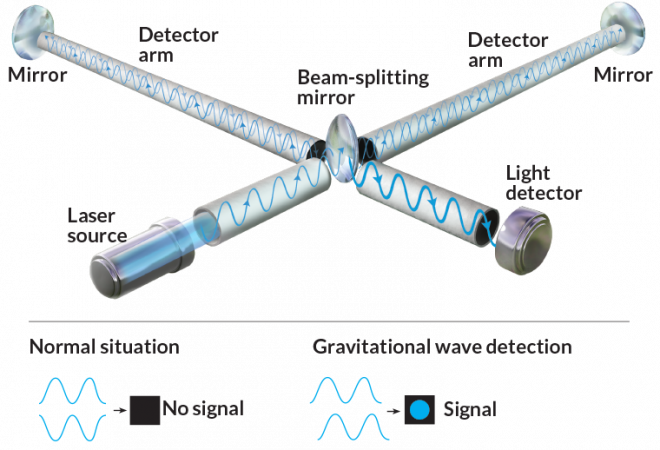Trio wins physics Nobel for detecting gravity waves
Prize awarded quickly for LIGO masterminds

In this illustration, two black holes are colliding. Such an event produced the gravitational waves detected by LIGO.
SXS, the Simulating eXtreme Spacetimes (SXS) project
By Emily Conover and Lisa Grossman
Subtle cosmic ripples kicked up by amazingly distant black holes have captured the public imagination. They also have grabbed the appreciation of a committee that evaluates Nobel Prize candidates. Today it announced the physics award would go to three Americans who laid the groundwork for the first direct detection of gravitational waves.
Rainer Weiss works at the Massachusetts Institute of Technology in Cambridge. Kip Thorne and Barry Barish work at the California Institute of Technology in Pasadena. Together, they will share the 9 million Swedish kronor (about $1.1 million) prize. Half will go to Weiss. Thorne and Barish will split the rest.
Researchers often wait decades before the Nobel committee recognizes their achievements. Not these three pioneers of LIGO. (That’s short for the Laser Interferometer Gravitational-Wave Observatory.) Not quite 20 months ago — on February 11, 2016 — LIGO announced the long-sought first detection of gravity waves. These particular ripples in spacetime had been generated by a pair of merging black holes.

The observation was the result of intense efforts by legions of scientists. It came a century after Albert Einstein had predicted such waves should exist. The frenzy of excitement that the waves generated captured front-page headlines around the world. Their confirmation was so monumental that the guiding team of physicists were honored almost immediately with a Nobel.
Indeed, says Clifford Will, “These detections were so compelling and Earth-shattering… Why wait?” Will is a physicist at the University of Florida in Gainesville and was not directly involved with the discovery. He said of the trio’s Nobel Prize today: “It’s fabulous. Absolutely fabulous.”
LIGO is an example of expensive, risky — but potentially revolutionary — science. “Gravitational waves contain information about their explosive origins and the nature of gravity that cannot be obtained from other astronomical signals,” France Córdova said in a statement. Córdova is the director of the National Science Foundation, a government agency that has invested some $1.1 billion into developing LIGO’s sensitive instruments. And now science is seeing a great payoff, she adds. LIGO’s observations “have created the new field of gravitational wave astronomy.”
Watching the arms of LIGO
LIGO was developed, in part, to test a prediction of Einstein’s general theory of relativity. Einstein had argued that rapidly accelerating massive objects would stretch and squeeze spacetime. This action should set in motion ripples that would move outward from the source. Despite looking for these waves for the better part of a century, none appeared — until last year.
“If Einstein was still alive, it would be absolutely wonderful to go to him and tell him about the discovery. He would be very pleased, I’m sure of it,” Weiss said at a news conference at MIT a few hours after he got word of the win. “But then to tell him what the discovery was, that it was a black hole, he would have been absolutely flabbergasted.”
An enthusiastic group of team members clad in LIGO-themed T-shirts gave the news conference celebrating the award a party-like atmosphere. There, Weiss stressed that the discovery was a group effort. “I’m a symbol of that. It’s not all on my shoulders, this thing,” he said. He then cited the large collaboration of scientists whose work led up to LIGO’s detection.
Scientists now hope to begin surveying the universe in a new way, by feeling for oh-so-subtle ripples in spacetime. Doing so “will allow us to see the parts of the universe that were not revealed to us before,” says Carlos Lousto. A LIGO team member, he works at the Rochester Institute of Technology in New York.
LIGO officially began collecting data in 2002. It ran on and off until 2010. Throughout, it turned up no hints of gravitational waves. So scientists designed a host of upgrades to make it more sensitive. The souped-up system is now known as Advanced LIGO. It began searching for spacetime ripples in 2015. Almost at once, scientists detected super-tiny ripples. They pointed to a black-hole collision. Those ripples, spotted on September 14, 2015, had journeyed to Earth from 1.3 billion light-years away. There, two colossal black holes had spiraled inward toward one another. Eventually they merged into one.
Story continues below image.

Quivers from those converging black holes were converted into an audio signal. They made a tell-tale “chirp.” It sounded a bit like a bird’s cry. The particulars of that signature reveal details of the collision. “The beauty of the symphony is in what you can extract from the tiny wiggles, or the wiggles on tops of wiggles, in that signal,” Thorne said today at a news conference at Caltech.
Since that first detection, LIGO scientists have observed three additional black-hole collisions. Additional gravitational ripples may already be in the bag: There are rumors that LIGO scientists have detected a smashup of neutron stars. Weiss hinted that another announcement is planned for October 16.
LIGO consists of two enormous L-shaped detectors. One stretches across the wooded landscape of Livingston, La. The other sprawls across a desert in Hanford, Wash. Each has two 4-kilometer- (2.5-mile-) long arms. A laser’s light bounces back and forth between mirrors at the elbow of LIGO’s L-shape and the ends of the arms that project out from it.
Gravity waves passing through a detector will stretch one arm very slightly. At the same time, they will shorten the other. LIGO compares the arms’ lengths using the laser light. It can detect differences in length that are smaller than the size of a proton.
“LIGO is probably one of the best and most amazing instruments ever built by mankind,” Barish said at the Caltech news conference. But building it was a risky endeavor. No one had previously attempted anything like it. And no one could say for sure whether the effort would succeed. “What’s fundamental is you have to be willing to take risks to do great things,” Barish said.
In August 2017, both LIGO detectors teamed up with a similarly designed Virgo detector near Pisa, Italy. The latest sighting of a spacetime ripple was made seven weeks ago. It showed up in all three detectors. This allowed scientists to pinpoint more precisely than ever the site of a pair of colliding black holes.
Story continues below image.

Getting to LIGO
In the 1960s, Weiss came up with the idea for a laser gravitational-wave detector. It was while he was teaching a class on general relativity. (Other researchers had independently proposed the technique as well.) The work began with some scribbles on scraps of paper. It eventually moved on to early prototypes.
Thorne became inspired by a conversation with Weiss. He assembled a team to work on the technique at Caltech in the ’70s. (Thorne, by the way, was a 1958 semifinalist in the Science Talent Search. It’s a program of Society for Science & the Public, which publishes Science News for Students.)
Ronald Drever, another LIGO founder, died in March. In the ’70s, he had been working on gravitational-wave detectors at the University of Glasgow in Scotland. Eventually, Drever joined Thorne at Caltech in 1979. Weiss and Drever each worked individually on prototypes. Then Weiss officially teamed up with Thorne and Drever in 1984 to create the initial LIGO device. Drever did live to hear of the first detection, Will says. Still, the Florida researcher adds, “It’s sad that he didn’t live to see it all.”
Barish joined the project later. In 1994, he became director of LIGO. He stayed on in that role for more than 10 years. Over that time, he elevated LIGO from scientists’ daydreams into reality. Barish oversaw the building of the LIGO detectors as well as their first searches for gravity waves. “He entered the experiment in a crucial moment,” notes Alessandra Buonanno. She is a LIGO team member and works at the Max Planck Institute for Gravitational Physics in Potsdam, Germany. This was a time “when it was necessary to bring the experiment to a different level, make it a big collaboration,” she says.
Speculation that LIGO would nab a Nobel began as soon as the first discovery was announced last year. “We were certainly expecting this,” says LIGO team member Manuela Campanelli. She works at the Rochester Institute of Technology.
But expecting it didn’t make the win any less sweet. “I feel in a dream,” says Buonanno.
LIGO and Virgo are currently in a shutdown period. Scientists are tinkering with the detectors to further improve their sensitivity. The hunt for ripples in spacetime will resume next year. Besides black-hole mergers and neutron-star smashups, scientists might one day also spot waves from an exploding star, known as a supernova. Future generations of these detectors might even sense trembles generated in the Big Bang. That would provide a glimpse of the universe’s beginnings.
Scientists might even turn up phenomena that have not yet been predicted. “I await expectantly some huge surprises in the coming years,” Thorne says.
H. THOMPSON, E. OTWELL, LIGO, SXS, NASA







